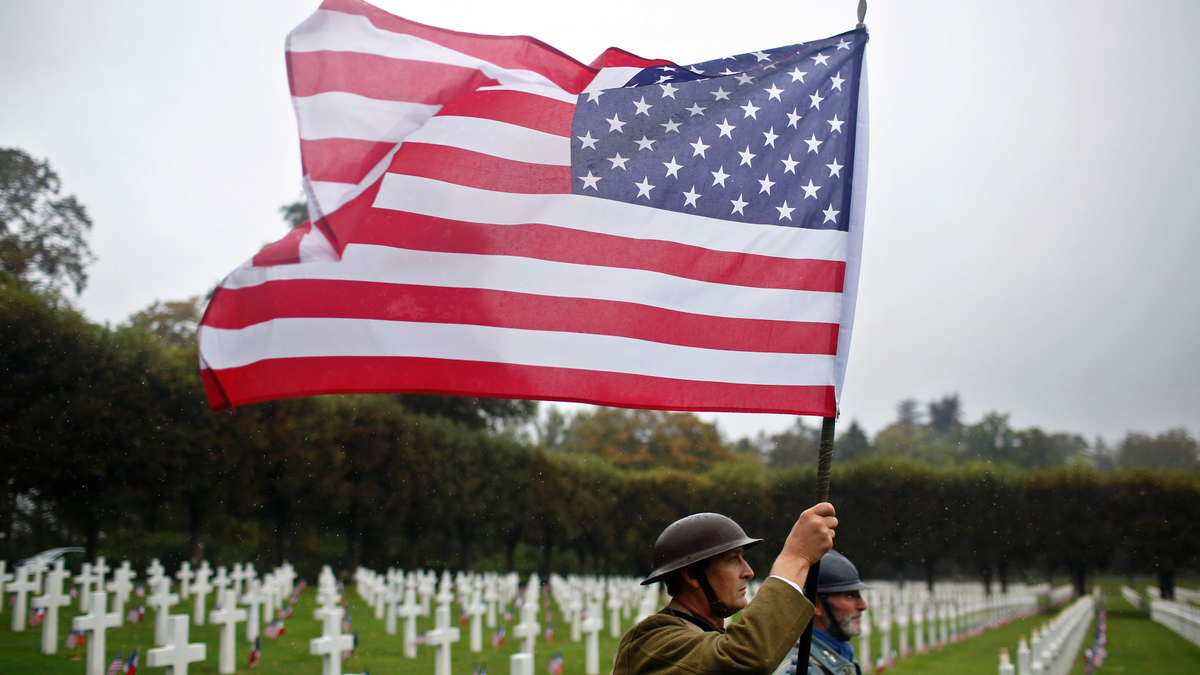
FILE In this Sunday, Sept. 23, 2018 file photo, re-enactors in World War I military uniforms carry an American flag in the Meuse-Argonne Cemetery, northeastern France. After the United States declared war on Germany in April 1917, its standing army of 127,500 became an armed force of 2 million within 1 ½ years. On Nov 11, 1918, allies like Britain and France were exhausted, Germany was as good as defeated and U.S. Gen. John J. Pershing had another 2 million troops ready to come over. (AP Photo/Thibault Camus, File)
One hundred years ago this Sunday, an armistice ended the fighting in the Meuse-Argonne region of France. To say it was welcome would be a vast understatement: Between September 26 and November 11, 1918, more than a million American soldiers had been engaged in fierce battle against the depleted but determined forces of imperial Germany. With more than 26,000 dead and more than 95,000 wounded, the battle stands as the bloodiest single military engagement in U.S. history.
Few of us, however, are aware of this. We recognize Gettysburg and Antietam, know about VE day and VJ Day, and visit Pearl Harbor and the beaches at Normandy. But very few of us realize that Veteran’s Day isn’t merely a celebration of those who have risked their lives for our country. November 11th wasn’t an arbitrary selection. It commemorates the sacrifices made in World War I – a war that the armistice in the Meuse-Argonne ended and about which many Americans frequently forget.
And even though permanent peace eluded the generation who fought that war – and, for that matter, every generation before and since – we owe these forebears the decency and respect of remembering their sacrifice with, at the very least, some serious moments of grateful reflection on its hundred-year anniversary.
On a gentle slope of one of the many ridges across which the U.S. troops pounded their way during those final 47 days of fighting in 1918, a cemetery containing 14,246 burials from the ranks of the American forces bears everlasting witness to what our countrymen have come to understand as the cost of freedom. This burial ground, complete with an impressive chapel, white marble headstones in the shape of Latin crosses and Stars of David, inscriptions naming the missing from the battle, engraved tributes to the dead and expressions of hope to the survivors, is the largest of twenty permanent American cemeteries from the two World Wars in Europe and the second-largest of 22 such places worldwide.
The federal agency responsible for the preservation of these hallowed sites is the American Battle Monuments Commission, established in 1923 and led for the first quarter century of its own history by General of the Armies John J. Pershing, the commander of the American Expeditionary Forces during the World War I. Pershing rightly considered the Meuse-Argonne to have been his most important battle and he visited the cemetery there, as well as the other seven permanent American burial grounds from that war – one in England, one in Belgium, and five more in France – every year through 1939 until the onset of World War II and the infirmities of age prevented him from overseas traveling.
Sadly, very few Americans show similar dedication. World War I sites – whether because of the remote locations of the cemeteries, or because many do not know these places exist, or because our level of interest in them does not compel us to seek them out – very rarely see visitors from the U.S. What’s more, no sitting president of the United States has ever visited the Meuse-Argonne Cemetery, and only George W. Bush and Barack Obama called at any of the World War I sites during their White House years. Most of the people who do visit them are citizens of the host countries. On major ceremonial occasions like American Memorial Day or the anniversaries of Armistice Day, they turn out in droves to honor our fallen heroes.
The lack of American visitors, however, takes nothing away from the significance of the sacrifice made at the Meuse-Argonne. Every hour of every day, whether visited or not, the dead lie peacefully amidst the compelling beauty of the battlefield cemeteries, bearing uninterrupted witness to their willingness to die for what the United States has always claimed as its own undying commitment to the defense of freedom.
As this year’s Veterans Day observance joins with the centennial observance of the end of World War I, let us honor and remember with gratitude not merely the living who have worn the nation’s uniform, but the dead as well – especially those who perished in the oft-forgotten Great War. In their common example of courage and selfless devotion to duty, all of them are still serving their country.



















